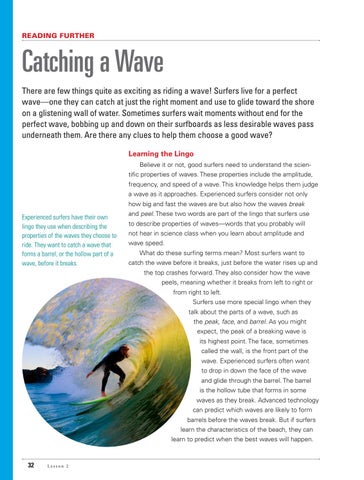READING FURTHER
Catching a Wave There are few things quite as exciting as riding a wave! Surfers live for a perfect wave—one they can catch at just the right moment and use to glide toward the shore on a glistening wall of water. Sometimes surfers wait moments without end for the perfect wave, bobbing up and down on their surfboards as less desirable waves pass underneath them. Are there any clues to help them choose a good wave? Learning the Lingo Believe it or not, good surfers need to understand the scientific properties of waves. These properties include the amplitude, frequency, and speed of a wave. This knowledge helps them judge a wave as it approaches. Experienced surfers consider not only how big and fast the waves are but also how the waves break
Experienced surfers have their own lingo they use when describing the properties of the waves they choose to ride. They want to catch a wave that forms a barrel, or the hollow part of a wave, before it breaks.
and peel. These two words are part of the lingo that surfers use to describe properties of waves—words that you probably will not hear in science class when you learn about amplitude and wave speed. What do these surfing terms mean? Most surfers want to catch the wave before it breaks, just before the water rises up and the top crashes forward. They also consider how the wave peels, meaning whether it breaks from left to right or from right to left. Surfers use more special lingo when they talk about the parts of a wave, such as the peak, face, and barrel. As you might expect, the peak of a breaking wave is its highest point. The face, sometimes called the wall, is the front part of the wave. Experienced surfers often want to drop in down the face of the wave and glide through the barrel. The barrel is the hollow tube that forms in some waves as they break. Advanced technology can predict which waves are likely to form barrels before the waves break. But if surfers learn the characteristics of the beach, they can learn to predict when the best waves will happen.
32
Lesson 2
